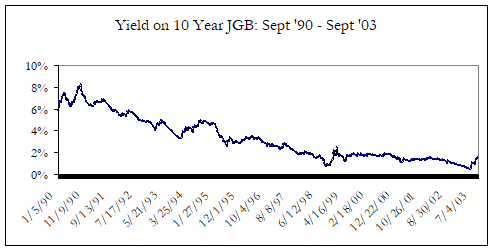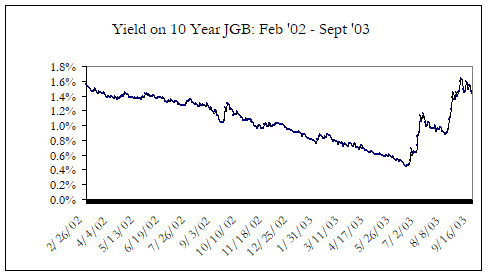Equinox Partners, L.P. - Q2 2003 Letter
Dear Partners and Friends,
Equinox's Performance
For the second quarter of 2003, Equinox Partners appreciated 19.1%, bringing our year-to-date return to 13%.
Our second quarter results reflect superior stock picking on the long side and improved risk control on the short side. Earlier this year, in an effort to control risk, we reduced the size and beta of our aggregate short position. We have partially offset this reduction in our short exposure through the purchase of attractively priced put options. As a result of this adjustment, we have achieved a better balance in our fund. At present, our delta-adjusted net long exposure is less than fifty percent of partners’ capital, and given the correlative tendencies of our hard asset-laden long positions, we estimate our effective net long exposure to be close to zero.
Financial market extremes have provided a plethora of very profitable investment opportunities over the last three years, but surprisingly few other generalist hedge funds have produced returns as good as ours.[1] The significant performance divergence between Equinox and most of our peers illustrates the distinctive element in our investment process--Equinox’s unceasing focus on exploiting very large valuation anomalies, both long and short, wherever they may be. These extremes continue to persist, and we continue to focus on the economics of their unwinding.
The Veneer of Normalcy
In recent months, the growing expectation of a cyclical economic upturn has bestowed a veneer of normalcy on global markets. Mutual fund inflows have resumed, the already expensive NASDAQ is up 40% year-to-date, pricey residential real estate remains the asset of choice, and all the while the average American consumer continues to blithely live far beyond his means. Investment professional Harold Evensky observes that investors “haven’t learned a thing, which is scary.”
But present financial reality is anything but normal! Witness the ongoing debate about unorthodox reflationary monetary policy. While investors and consumers alike remain apparently unphased by these extraordinary economic conditions, the worlds’ central bankers are visibly worried. The reflexive combination of falling prices and over-indebtedness is economically lethal, so clearly so that central bankers will do virtually anything to prevent the onset of deflation. Take, for example, Ben Bernanke’s recent speech to a gathering of Japanese central bankers. Bernanke focused on unconventional deflation avoidance schemes, a disturbingly relevant topic for central bankers both here and in Japan. Simply put, this gathering of the world’s foremost “serial bubble creators” represents the most recent attempt to paper over the natural business cycle. Equinox’s value-based portfolio remains well positioned to continue benefiting from the current unstable mixture of unorthodox global monetary policy and the historically significant financial imbalances such policy is meant to address.
Shorting Japanese Government Bonds (JGBs)
‘Historically unique’ is the best way to characterize the past few years of trading in the ¥en fixed income markets. New territory was first charted in 2001 when the Bank of Japan (BOJ) zeroed out overnight rates. However, the most extraordinary interest rate, a ten year bond yielding less than half of one percent, was posted just this summer. That this record low yield was put in after long-time BOJ monetary “hawk,” Masaru Hayami, was replaced by the less orthodox Toshihiko Fukui, is almost beyond comprehension.
With yields so unbelievably low, our instinct was to short the bonds and thereby capitalize on the inherent price asymmetries. Even if yields on this bond had dropped to zero (zero seemed unlikely for obvious reasons), we would have only lost five percentage points on our short position. Those who have shorted stocks, especially during the 1990’s, will surely appreciate the special attraction of this most lopsided distribution of outcomes.
We further discovered that the consistent manner in which the ten year JGBs had appreciated over the past year encouraged the major bank derivative desks to assign a relatively low volatility to this security. Any self-respecting Buffett aficionado knows something a derivative trader does not: volatility is not risk. So, while the appreciation in the JGBs did not reduce their risk profile, it afforded us the opportunity to buy very inexpensive long dated put options with a very modest amount of our partners’ capital, thereby benefiting as yields rise. In our opinion, whether the macroeconomic situation in Japan deteriorated or improved, yields on the ten year JGBs were likely to rise substantially and we were likely to profit. As shown below, this outcome has already come to pass.
Global Investing
Our funds’ decision to exploit the dramatic overvaluation of the JGB instead of the more commonly employed strategy of shorting depressed but still overpriced technology shares has been a profitable one. Not only have we made significant profits on our JGB puts, but we have also avoided what would have been a serious loss on technology stock shorts. It was our knowledge and experience in Asia, Japanese economic and monetary developments in particular, that enabled us to identify the obviously more attractive course of action. In the years ahead, we are confident that our global perspective and attention to risk avoidance will continue to prove invaluable.
Sincerely,
Sean Fieler
William W. Strong











